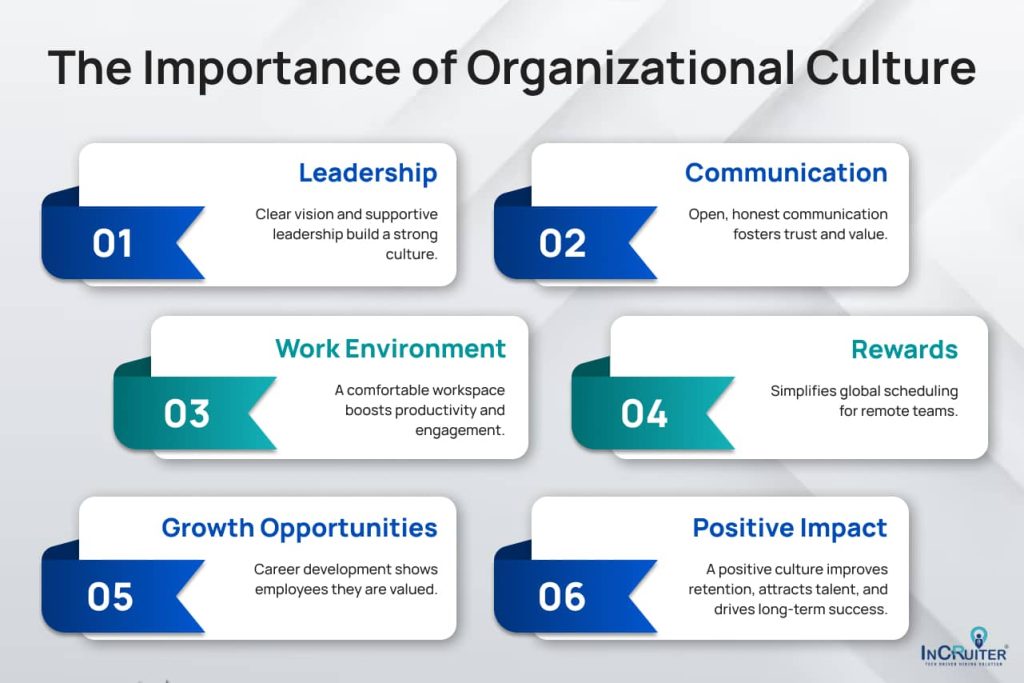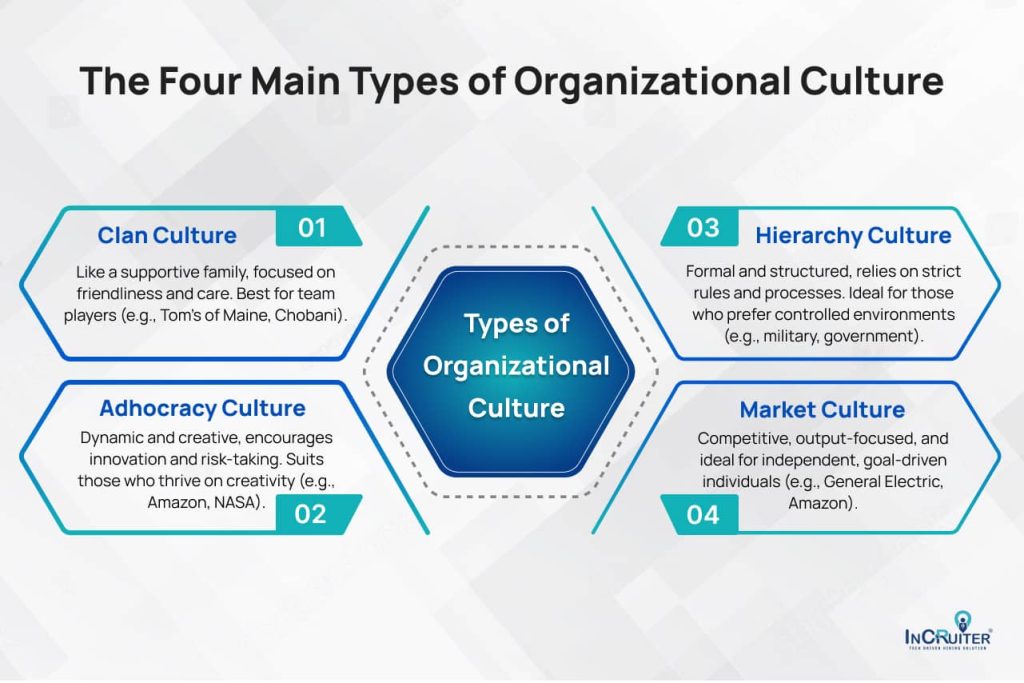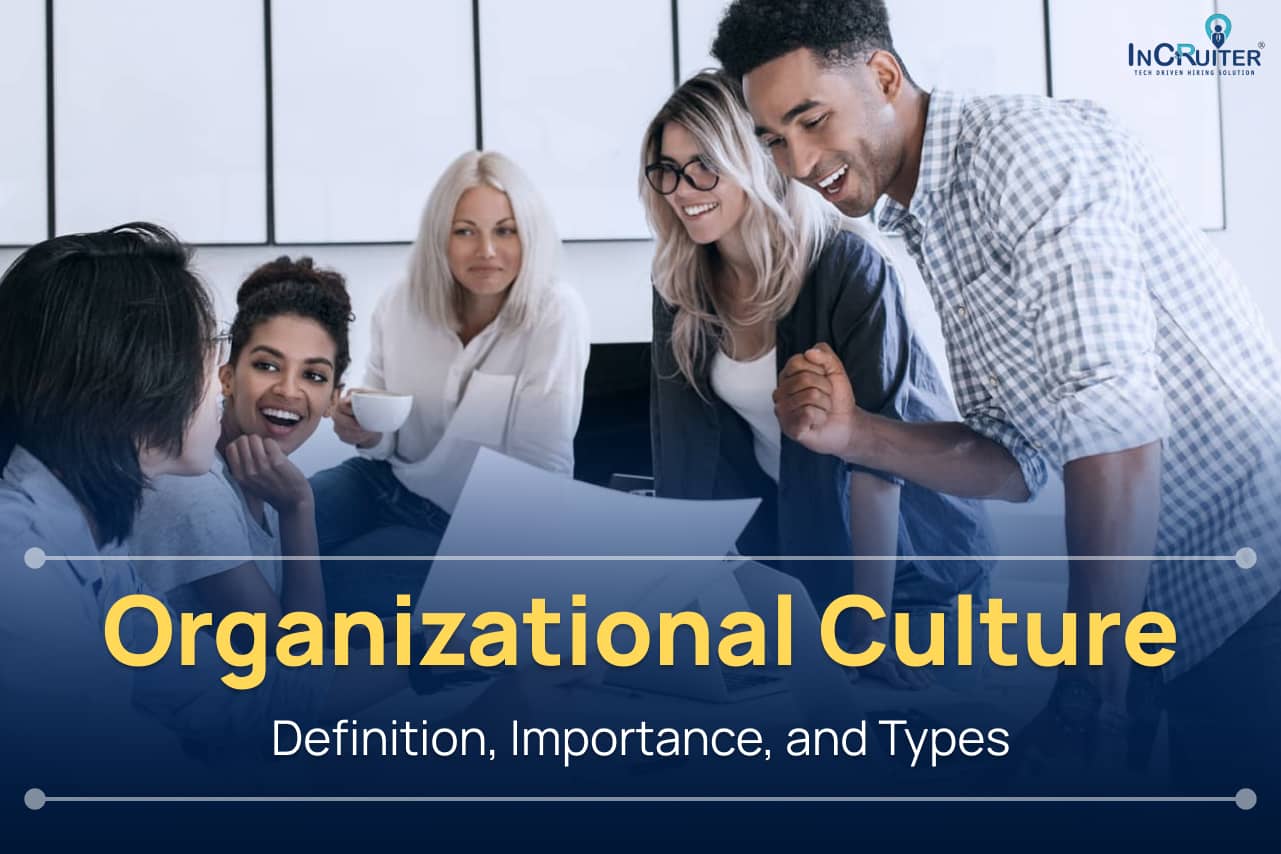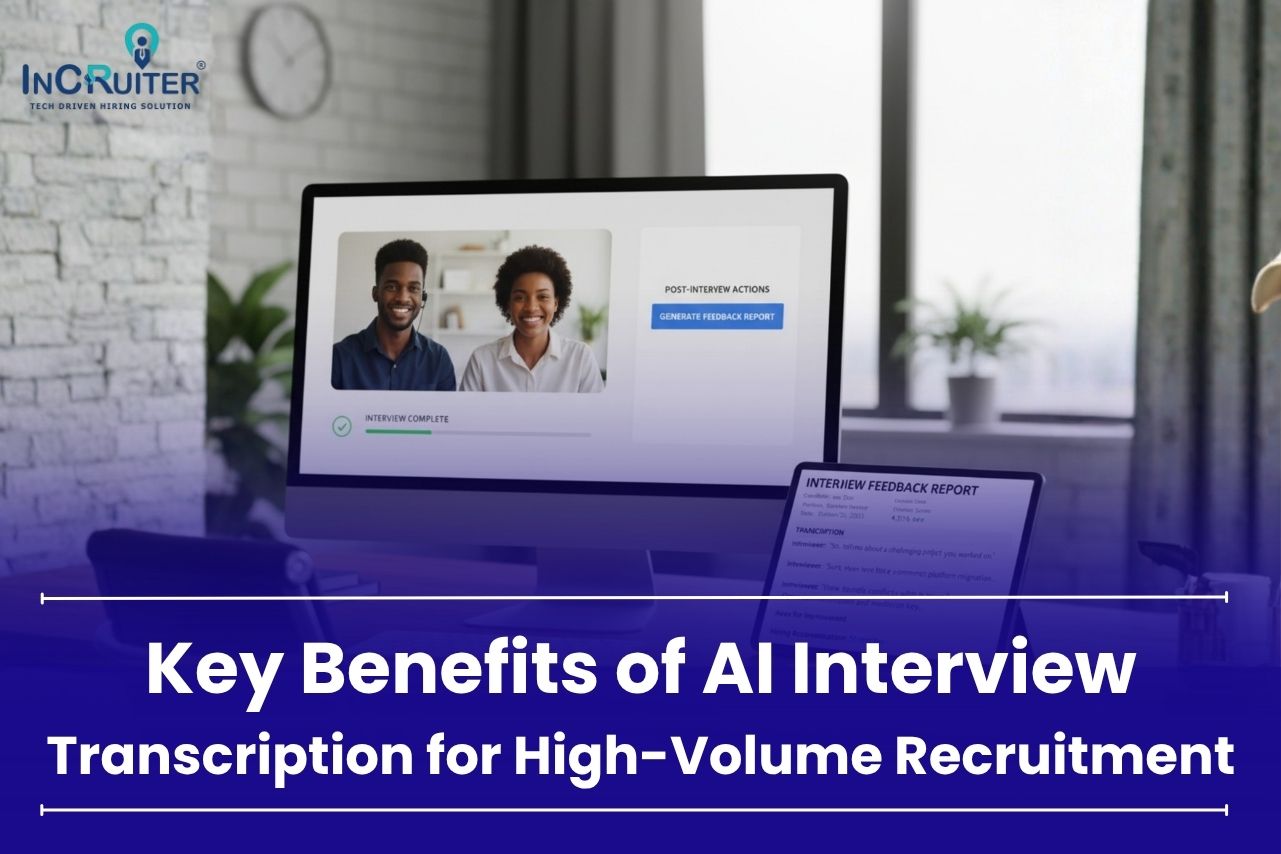When an organizational culture is based on shared values and a clear mission, it not only strengthens identity but also helps to match activities with long-term objectives, paving the way for company resilience and profitability.
What Is Organizational Culture?
Organizational culture is the soul and heart of a business, not merely a catchphrase. It consists of the principles, ideas, convictions, and guidelines that mold staff behavior and interactions. Like a compass, a strong culture is a powerful tool that helps employees bring change while ensuring the right direction toward a robust and profitable business.
Also read: Relevance of Interview as a Service in the Modern World
Significance of Organizational Culture in Business Success
A healthy culture is not only a must; it is also vital for companies’ success. It affects everything, including reputation, personnel retention, and output. 77% of employees think about culture when they apply for a job, and many are ready to change jobs to fit into a thriving culture. That is rather good proof of the value of culture! Companies like InCruiter are known to foster inclusivity by prioritizing culture.
We are providing a list of the top 5 tech firms, along with the ranking of cultural value.
| Rank | Company | Culture and Value Rating (out of 5) |
| 1 | Dropbox | 4.64 |
| 2 | Samsara | 4.63 |
| 3 | Deltek | 4.61 |
| 4 | Databricks | 4.58 |
| 5 | NVIDIA | 4.58 |
Why Organizational Culture Matters

- Effective Leadership: Leadership that encourages staff members and presents a clear vision helps to build a good culture.
- Communication Styles: Open and honest communication helps to create trust and gives staff members worth and hearing.
- Work Environment: A well-designed, comfy desk can offer better productivity and employee involvement.
- Rewards Systems: Employee recognition and appreciation of small wins uplift morale and create healthy work involvement.
- Opportunities for Growth: Career development chances show staff members that the company values their future, boosting their involvement.
- Positive Cultures: Positive cultures help companies by improving staff retention production and increasing reputation. They are more likely to draw great talent and find success over the long run.
Advantages of a Strong Organizational Culture
Enhanced Recruitment and Retention
Top talent is attracted powerfully by a solid corporate culture. Recruitment and retention are much affected by a good workplace that gives employees well-being and development chances as a top priority. For instance, Incruiter keeps a positive employer brand, which is critical for attracting talent. Google and Netflix are the pinnacle of creative and cooperative culture, and they have produced a devoted, top-notch staff.
Increased Employee Engagement and Productivity
Innovatech observed a stunning 45% increase in employee satisfaction ratings, credited to their leaner culture approach. This culture promotes efficiency and productivity in the company. Likewise, TechWave’s embrace of a values-driven culture resulted in a 60% increase in participation within a year.
Strengthened Brand Identity
A firm’s culture represents its brand personality, beliefs, and goals. It also helps to draw in and keep loyal consumers, staff members, and partners. It builds an environment of loyal partners and customers with a shared brand vision. For example, brands like Coca-Cola and Airbnb maintain clever customer engagement. These marketing campaigns foster a sense of connection and community.
Long-Term Benefits of a Positive Organizational Culture
Organizational culture significantly influences the workplace by encouraging innovation, creativity, and employee pleasure. With its excellent culture enhancing employee involvement and attaining 47 years of success, Southwest Airlines stands out as demonstrating this above its rivals.
Sustainable Growth and Innovation
Companies like Google and Patagonia show how culture inspires creativity. Patagonia’s commitment to environmental responsibility has strengthened its market leadership. Google’s ‘20% self-time’ philosophy, which allows employees to spend 20% of their work time on personal projects, promotes personal projects that result in innovative ideas.
Improved Customer Satisfaction and Loyalty
The relationship between internal culture and customer experience is solid. Businesses that match their culture with consumer values usually shine in customer satisfaction. For instance, Amazon’s “Day 1” approach guarantees constant attention to customer demands. Interestingly, Zappos has developed its name based on a culture that values outstanding customer care. These businesses show how improved internal culture may result in loyalty and better client experiences.
Also read: Pre-Employment Checks: Hiring the Right Candidates
The Four Main Types of Organizational Culture

Organizational cultures vary. They have different ideas, assumptions, and values. These guide a company’s behavior and decisions. We will now cover the four main culture categories. This will help you find a business that fits your preferred culture.
Clan Culture
Clan culture resembles a giant, encouraging family. This culture fosters a workplace where friendliness and care thrive together. Though tricky for newcomers at first, team players will find great joy. Tom’s of Maine, Redmond (Real Salt), and Chobani have clan cultures. They value their employees.
Adhocracy Culture
Adhocracy culture is dynamic and creative. It has high cooperation and risk-taking features. This society encourages innovation, inquiry, and audacious ideas. It is ideal for individuals who prefer working on set schedules. Amazon, Wikipedia, and NASA are some examples of adhocracy culture.
Hierarchy Culture
Hierarchical culture maintains a disciplined and formal environment. It relies on strict processes and rules. Workers must follow strict policies outlined in manuals. This society is a good fit for people who thrive in controlled surroundings. Military organizations, government agencies, and educational institutions are examples of hierarchical culture.
Market Culture
Driven by competition and goal-oriented conduct, market culture stresses output and results. Targeting the most significant revenue sparks employee productivity and streamlines work processes. Those who are more introverted and self-sufficient will fit this culture. Bluecore, General Electric, and Amazon are examples of market culture.
Identifying and Developing Your Organizational Culture
Assessing Current Culture
Assessing company culture calls for time and money. Follow these guidelines to create a quick overview of your present culture:
- Check Your Values: Your core principles must align with employees’ and leaders’ views.
- Review Hiring Practices: To improve performance and diversity, check new hires’ values. They must align with your business morals.
- Check Employee Programs: Ensure your performance, awards, and onboarding programs reflect your business’s values.
- Listen to Your People: Open talks can help get employees’ views. They can clarify the current culture and promote a shared vision for the future.
Aligning Culture with Company Goals
Aligning your organizational culture with the company’s goals involves strategic planning. Here are some steps to ensure that culture supports your business objectives:
- Clear Cultural Goals: Set cultural goals that align with your strategic ones. Please share them with your staff.
- Patience is the key: Help staff adapt and install cultural shifts in phases. Don’t overburden them.
- Reinforce Desired Behaviors: Reward actions that fit the intended culture. Recognition will help spread those values throughout the company.
Fostering a Positive Organizational Culture
This section guides how outstanding leadership and communication can build a positive culture. Overcoming challenges can lead to a brand’s long-term success. One challenge is resistance to cultural change.
1. Strategies to Build and Maintain a Healthy Organizational Culture
A leader directs a team towards the best outputs. Here are some insights to leverage your leadership qualities.
Leadership’s Role in Shaping Culture
Leadership plays a primary role in shaping any organizational culture. Leaders define the standards for a customer-centric culture. Their actions and choices reflect the company’s values and goals. Leaders influence culture through integrity towards tasks. Offering fair treatment and approachability may also inspire involvement among the team. Good communication and appreciation can inspire people. They may help to teach a positive culture in the corporate hive.
Checklist some key points that make a leader supportive.
- Encourage team success: Leaders highlighting cross-functional cooperation promote an inventive and cooperative culture.
- Authorizing Staff: Giving staff decision-making power makes them feel valued. It boosts their drive and creates a better workplace.
- Employee satisfaction: Motivated employees foster a positive work environment through their enthusiasm.
- Building a Supportive environment: Employee well-being should first concern leaders, who should also honour diversity. This helps to shape a society that draws and keeps outstanding talent.
Encouraging Open Communication and Collaboration
Organizational culture is primarily dependent on open and honest communication. It promotes transparency, helps to clear misunderstandings, and improves relationships. Accessible communication flow helps employees perform their best and fosters loyalty.
Listing the four fundamental ideas that represent open communication:
- Wipe out Ego: Egotism can dominate talks and limit honest communication. Encouragement of a society whereby everyone’s voice is heard helps to avoid this.
- Building Trust: Trust makes fundamental interactions possible, allowing staff members to express their ideas and opinions.
- Better training: Training in active listening and other communication techniques helps everyone in the company to be more suited to communicate honestly.
- Utilizing Tools: Establishing channels for updates, comments, and teamwork guarantees everyone access to the required tools for information and communication.
Recognizing and Rewarding Cultural Alignment
According to a study, aligning an organization’s people and culture can result in up to 9% improved performance against revenue targets. Uniting employees to your company’s culture helps create a standard knowledge of the aims and strategies to reach them.
These are ideal guidelines for initiatives in cultural awareness:
- Appreciate behavior: Acknowledging and rewarding actions that fit the desired culture strengthens such principles. Surveys suggest that 92% of employees are more likely to repeat an action they’re recognized for.
- Resolve disconnection: Provide secure, anonymous feedback routes to help employees grasp and resolve cultural differences.
- Live by Company Values: Make sure values are distinctive, precisely expressed, and modeled by all.
2. Challenges in Maintaining a Strong Organizational Culture
Maintaining a good culture gets more complex as companies expand. Your company’s spirit and fundamental values should stay firm with careful management. Let us guide you through some tricks to overcome these hurdles and achieve a solid organizational culture.
Adapting Culture During Growth and Change

- Mindful Hiring: Careful hiring guarantees new employees meet qualifications and match the corporate culture.
- Stress Your Motto: Center the company’s missions and goals in all communications and meetings.
- Conserve Traditions: Maintaining and valuing long-standing customs even as the company expands.
- Acknowledge Success: Frequent celebrations of staff efforts help to build satisfaction and loyalty.
- Accessible training: Ensure every staff member can access available training to remain close to the corporate culture.
- Communication tools: To keep everyone informed and involved, routinely follow up with staff members and keep informal lines of contact open through newsletters.
- Informal meet-ups: Encourage team-building events outside the office to deepen bonds and friendships.
Overcoming Resistance to Cultural Change
One typical difficulty in culture transition is resistance to cultural changes. Leaders ought to concentrate on overcoming this challenge by:
- Fostering Collaboration: Working with all employees means being open and sensitive to their issues and helping them participate in the cultural transformation.
- Paying Attention: Once changes are implemented, be sure they get ingrained in the culture by consistently following new policies.
- Communicate First: Early and frequent communication among staff members will help to avoid surprises by informing them about forthcoming changes.
- Acknowledge the Process: Making slow progressions will provide staff members with time to adapt.
- Gamification: Introducing games and incentives to make the acceptance of new cultural norms more exciting and less disturbing.
- Transparent Notions: Starting with a clear vision, make sure any cultural transformation complements the objectives of the business and that the values underlined are rewarded.
Also read: Role of Interview Intelligence Platforms in a Positive Candidate Experience.
Rising remote work, the digital revolution, and the growing relevance of mental health will change how businesses define their cultures. Flexible work hours and virtual team-building activities encourage many work types and give employee welfare a top priority. Businesses prioritizing a positive, inclusive, and dynamic culture will stand out to become more technologically savvy and globally linked.
To sum up, it is evident that implementing company culture is an HR responsibility and strategic teamwork. It shapes everything from brand identification to employee satisfaction and long-term viability. Concrete organizational cultures like Incruiter, salesforce, and Google have fostered settings where workers feel appreciated and involved. Therefore, it is proven that a correct cultural foundation can offshoot excellent results.
Recall that deliberate acts and leadership develop a good culture; it cannot arise by chance. Giving priority to communication, inclusiveness, and staff development will help you create a culture that resists aging and drives your company toward a bright future.



















